Multi-Objective Unified Optimal Control Strategy for DAB Converters with Triple-Phase-Shift Control
Abstract
:1. Introduction
2. Analytical Model of High-Efficiency Modes of TPS Control
2.1. High-Efficiency Modes Selection
2.2. Transmission Power and Current-Stress Characteristics
2.3. Soft-Switching Characteristics
3. The MUOC Strategy and Performance Analysis
3.1. The MUOC Strategy
3.2. Minimum Current Stress and ZVS Analysis
4. Experimental Results and Analysis
4.1. Steady-State Experimental Analysis
4.2. Dynamic Experimental Analysis
5. Conclusions
Author Contributions
Funding
Institutional Review Board Statement
Informed Consent Statement
Data Availability Statement
Conflicts of Interest
References
- Zhao, B.; Song, Q.; Li, J.; Liu, W.; Liu, G.; Zhao, Y. High-Frequency-Link DC Transformer Based on Switched Capacitor for Medium-Voltage DC Power Distribution Application. IEEE Trans. Power Electron. 2016, 31, 4766–4777. [Google Scholar] [CrossRef]
- Liu, J.; Yang, J.; Zhang, J.; Nan, Z.; Zheng, Q. Voltage balance control based on dual active bridge dc/dc converters in a power electronic traction transformer. IEEE Trans. Power Electron. 2018, 33, 1696–1714. [Google Scholar] [CrossRef]
- Xue, L.; Shen, Z.; Boroyevich, D.; Mattavelli, P.; Diaz, D. Dual active bridge-based battery charger for plug-in hybrid electric vehicle with charging current containing low frequency ripple. IEEE Trans. Power Electron. 2015, 30, 7299–7307. [Google Scholar] [CrossRef] [Green Version]
- Zhao, B.; Song, Q.; Liu, W.; Sun, Y. Overview of dual-active-bridge isolated bidirectional dc–dc converter for high-frequency-link power-conversion system. IEEE Trans. Power Electron. 2014, 29, 4091–4106. [Google Scholar] [CrossRef]
- An, F.; Song, W.; Yu, B.; Yang, K. Model predictive control with power self-balancing of the output parallel dab dc–dc converters in power electronic traction transformer. IEEE J. Emerg. Select. Top. Power Electron. 2018, 6, 1806–1818. [Google Scholar] [CrossRef]
- An, F.; Song, W.; Yang, K.; Luo, S.; Feng, X. Optimised power control and balance scheme for the output parallel dual-active-bridge DC-DC converters in power electronic traction transformer. IET Power Electron. 2019, 12, 2295–2303. [Google Scholar] [CrossRef]
- An, F.; Song, W.; Yang, K. Direct power control of dual-active-bridge dc–dc converters based on unified phase shift control. J. Eng. 2019, 2019, 2180–2184. [Google Scholar] [CrossRef]
- Bhattacharjee, A.K.; Batarseh, I. Optimum Hybrid Modulation for Improvement of Efficiency Over Wide Operating Range for Triple-Phase-Shift Dual-Active-Bridge Converter. IEEE Trans. Power Electron. 2020, 35, 4804–4818. [Google Scholar] [CrossRef]
- Hu, Y.; Zhang, Y.; Chen, Q.; Zhang, T.; Guan, Q.; Liu, Y.; Jia, Y.; Yu, J. Efficiency Evaluation for DAB Converter with Reactive Power Minimization Strategy and Full ZVS Operation. In Proceedings of the 2019 IEEE Energy Conversion Congress and Exposition (ECCE), Baltimore, MD, USA, 29 September–3 October 2019. [Google Scholar]
- Shi, H.; Wen, H.; Chen, J.; Hu, Y.; Jiang, L.; Chen, G.; Ma, J. Minimum-backflow-power scheme of dabbased solid-state transformer with extended-phase-shift control. IEEE Trans. Ind. Appl. 2018, 54, 3483–3496. [Google Scholar] [CrossRef]
- Huang, J.; Wang, Y.; Li, Z.; Lei, W. Unified triple-phase-shift control to minimize current stress and achieve full soft-switching of isolated bidirectional dc–dc converter. IEEE Trans. Ind. Electron. 2016, 63, 4169–4179. [Google Scholar] [CrossRef]
- Hou, N.; Song, W.; Wu, M. Minimum-Current-Stress Scheme of Dual Active Bridge DC–DC Converter With Unified Phase-Shift Control. IEEE Trans. Power Electron. 2016, 31, 8552–8561. [Google Scholar] [CrossRef]
- Tong, A.; Hang, L.; Li, G.; Jiang, X.; Gao, S. Modeling and Analysis of a Dual-Active-Bridge-Isolated Bidirectional DC/DC Converter to Minimize RMS Current With Whole Operating Range. IEEE Trans. Power Electron. 2018, 33, 5302–5316. [Google Scholar] [CrossRef]
- An, F.; Song, W.; Yang, K. Improved dynamic performance of dual active bridge dc-dc converters using MPC scheme. IET Power Electron. 2018, 11, 1756–1765. [Google Scholar] [CrossRef]
- Hou, N.; Li, Y. Overview and comparison of modulation and control strategies for a nonresonant single-phase dual-active-bridge dc–dc converter. IEEE Trans. Power Electron. 2020, 35, 3148–3172. [Google Scholar] [CrossRef]
- Hou, N.; Li, Y. The Comprehensive Circuit-Parameter Estimating Strategies for Output-Parallel Dual-Active-Bridge DC–DC Converters With Tunable Power Sharing Control. IEEE Trans. Ind. Electron. 2020, 67, 7583–7594. [Google Scholar] [CrossRef]
- Song, W.; Hou, N.; Wu, M. Virtual Direct Power Control Scheme of Dual Active Bridge DC-DC Converters for Fast Dynamic Response. IEEE Trans. Power Electron. 2018, 33, 1750–1759. [Google Scholar] [CrossRef]
- Zhao, B.; Song, Q.; Liu, W. Efficiency Characterization and Optimization of Isolated Bidirectional DC–DC Converter Based on Dual-Phase-Shift Control for DC Distribution Application. IEEE Trans. Power Electron. 2013, 28, 1711–1727. [Google Scholar] [CrossRef]
- Gu, Q.; Yuan, L.; Nie, J.; Sun, J.; Zhao, Z. Current Stress Minimization of Dual-Active-Bridge DC-DC Converter Within the Whole Operating Range. IEEE J. Emerg. Sel. Top. Power Electron. 2019, 7, 129–142. [Google Scholar] [CrossRef]
- Tong, A.; Hang, L.; Li, G.; Guo, Y.; Zou, Y.; Chen, J.; Li, J.; Zhuang, J.; Li, S. Power flow and inductor current analysis of PWM control for Dual Active Bridge converter. In Proceedings of the 2016 IEEE 8th International Power Electronics and Motion Control Conference (IPEMC-ECCE Asia), Hefei, China, 22–26 May 2016. [Google Scholar]
- Jin, L.; Liu, B.; Duan, S. ZVS Soft Switching Operation Range Analysis of Three-Level Dual-Active Bridge DC–DC Converter Under Phase Shift Control Strategy. IEEE Trans. Ind. Appl. 2019, 55, 1963–1972. [Google Scholar] [CrossRef]
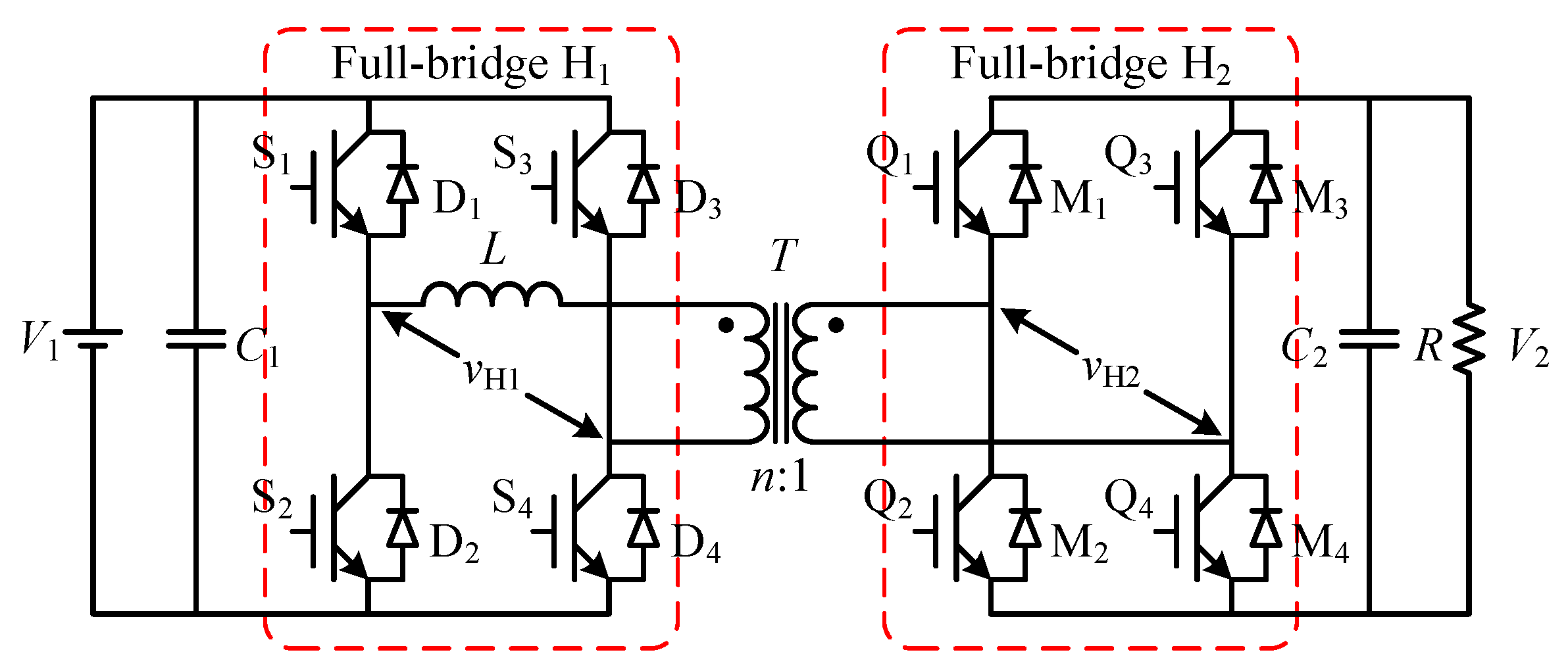
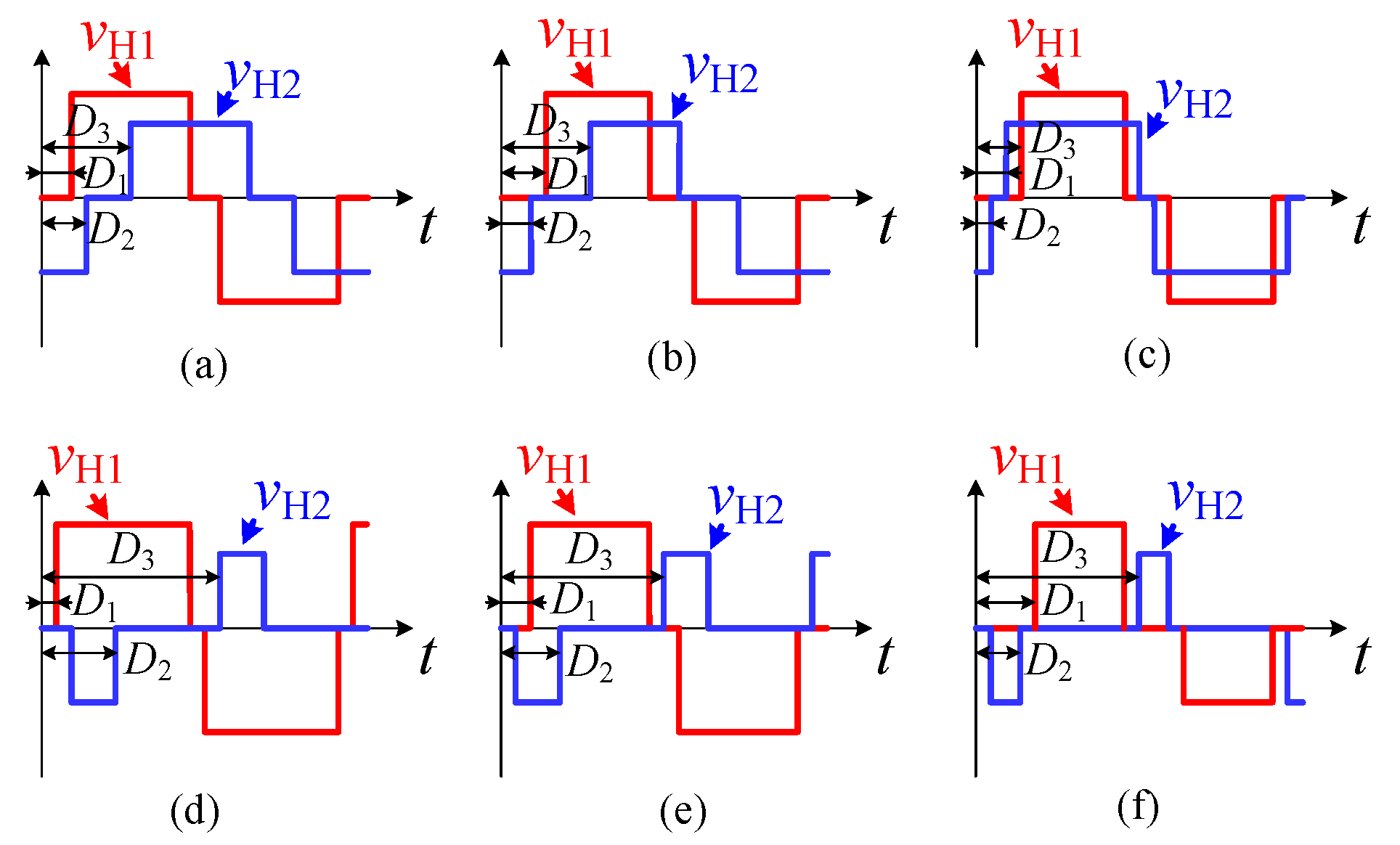

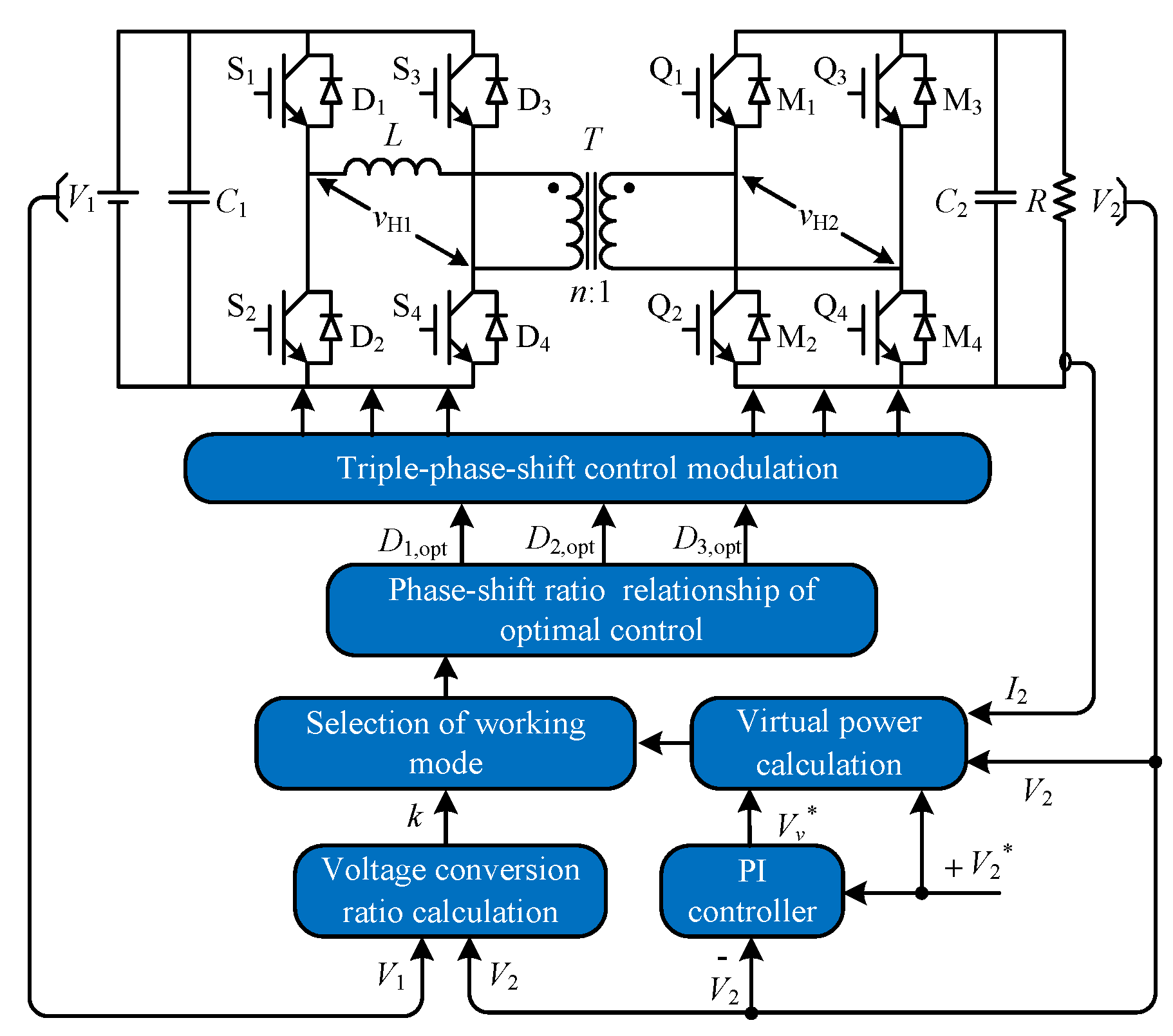

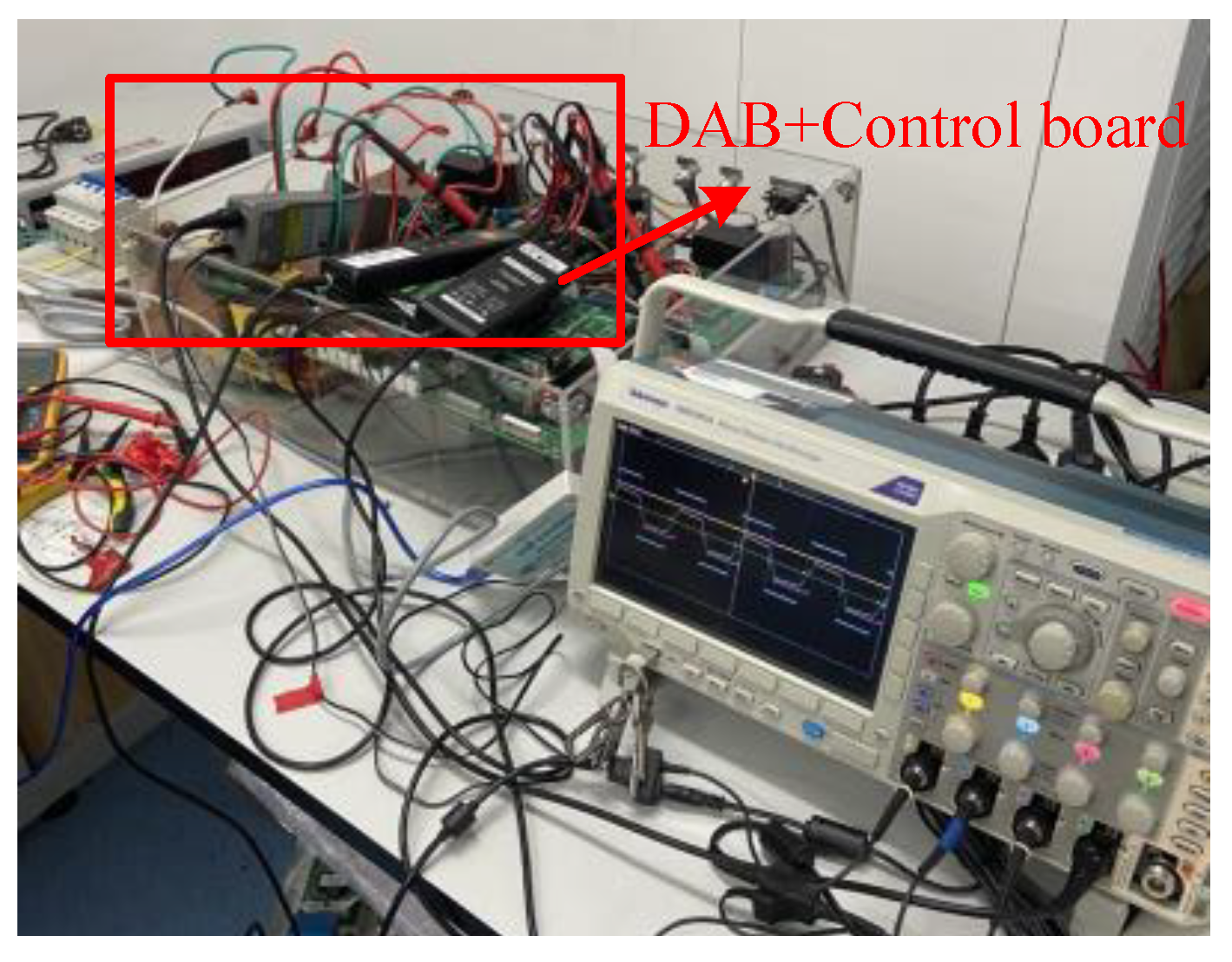

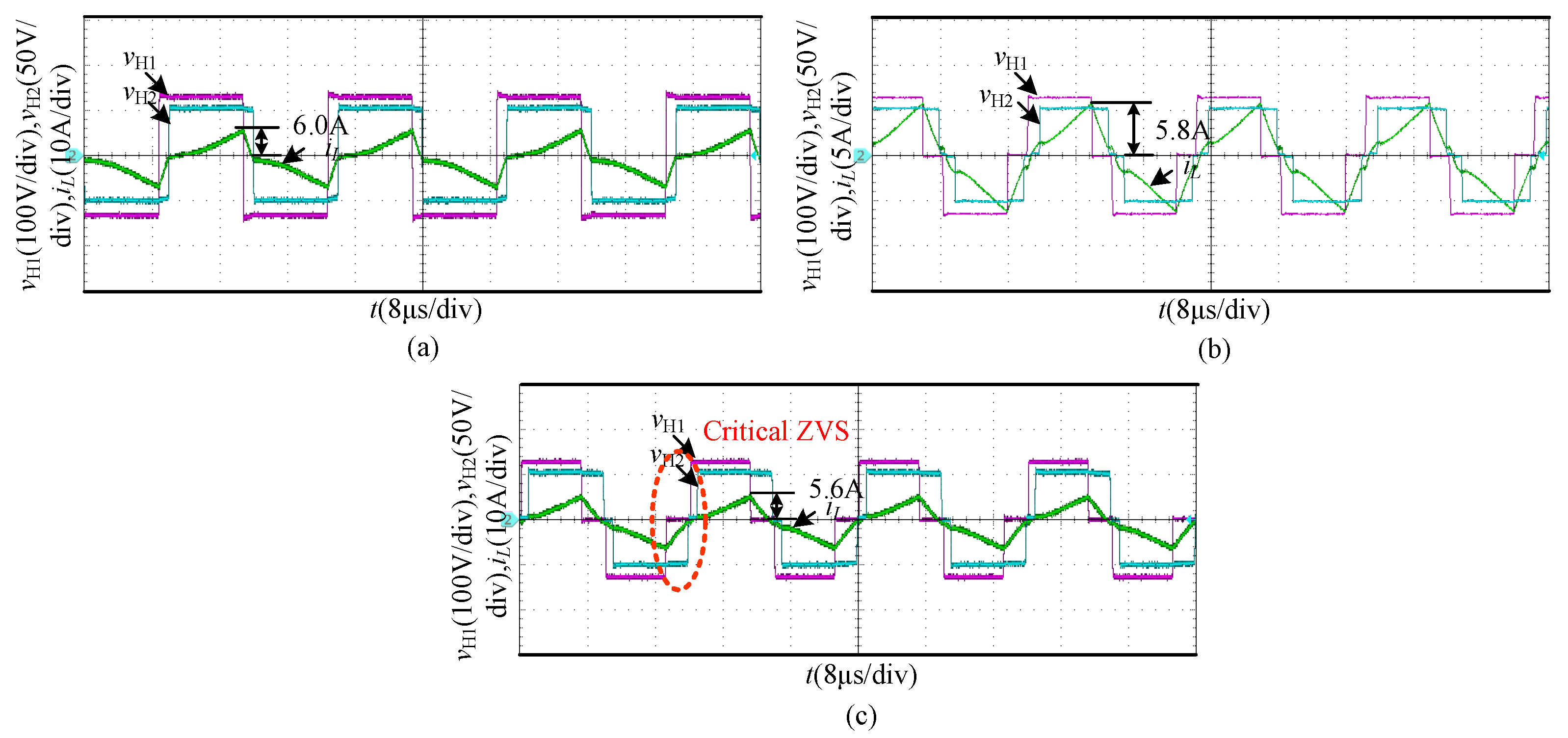



| Mode | The Ranges of Phase-Shift Ratio |
|---|---|
| mode 1 | |
| mode 2 | |
| mode 3 | |
| mode 4 | |
| mode 5 | |
| mode 6 |
| Mode | ZVS Range | |
|---|---|---|
| mode 1 | ||
| mode 2 | ||
| mode 3 | ||
| Control Strategy | The Range of Transmission Power | Minimum Current Stress |
|---|---|---|
| SPS control | ||
| DPS control | ||
| TPS control | ||
| Parameters | Value |
|---|---|
| Input voltage | |
| Output voltage | |
| Switching frequency | |
| Turn ratio of transformer | |
| Input DC capacitor | |
| Output DC capacitor | |
| Series inductor |
Publisher’s Note: MDPI stays neutral with regard to jurisdictional claims in published maps and institutional affiliations. |
© 2021 by the authors. Licensee MDPI, Basel, Switzerland. This article is an open access article distributed under the terms and conditions of the Creative Commons Attribution (CC BY) license (https://creativecommons.org/licenses/by/4.0/).
Share and Cite
Zeng, J.; Rao, Y.; Lan, Z.; He, D.; Xiao, F.; Liu, B. Multi-Objective Unified Optimal Control Strategy for DAB Converters with Triple-Phase-Shift Control. Energies 2021, 14, 6444. https://doi.org/10.3390/en14206444
Zeng J, Rao Y, Lan Z, He D, Xiao F, Liu B. Multi-Objective Unified Optimal Control Strategy for DAB Converters with Triple-Phase-Shift Control. Energies. 2021; 14(20):6444. https://doi.org/10.3390/en14206444
Chicago/Turabian StyleZeng, Jinhui, Yao Rao, Zheng Lan, Dong He, Fan Xiao, and Bei Liu. 2021. "Multi-Objective Unified Optimal Control Strategy for DAB Converters with Triple-Phase-Shift Control" Energies 14, no. 20: 6444. https://doi.org/10.3390/en14206444
APA StyleZeng, J., Rao, Y., Lan, Z., He, D., Xiao, F., & Liu, B. (2021). Multi-Objective Unified Optimal Control Strategy for DAB Converters with Triple-Phase-Shift Control. Energies, 14(20), 6444. https://doi.org/10.3390/en14206444





